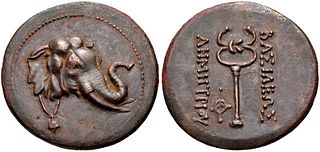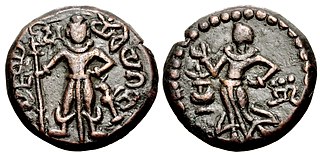
The middle kingdoms of India were the political entities in the Indian subcontinent from 230 BCE to 1206 CE. The period begins after the decline of the Maurya Empire and the corresponding rise of the Satavahana dynasty, starting with Simuka, from 230 BCE. The "middle" period lasted for almost 1436 years and ended in 1206 CE, with the rise of the Delhi Sultanate, founded in 1206, and the end of the Later Cholas.
Gandhara was an ancient Indo-Aryan civilization centred in present-day north-west Pakistan and north-east Afghanistan. The core of the region of Gandhara was the Peshawar and Swat valleys extending as far east as the Pothohar Plateau in Punjab, though the cultural influence of Greater Gandhara extended westwards into the Kabul valley in Afghanistan, and northwards up to the Karakoram range. The region was a central location for the spread of Buddhism to Central Asia and East Asia with many Chinese Buddhist pilgrims visiting the region.

The History of Punjab refers to the past history of Punjab region which is a geopolitical, cultural, and historical region in the northwest of South Asia, comprising eastern Punjab province in Pakistan and western Punjab state in India. It is believed that the earliest evidence of human habitation in Punjab traces to the Soan valley of the Pothohar, between the Indus and the Jhelum rivers, where Soanian culture developed between 774,000 BC and 11,700 BC. This period goes back to the first interglacial period in the second Ice Age, from which remnants of stone and flint tools have been found.

The Maurya Empire was a geographically extensive Iron Age historical power in South Asia based in Magadha. It was the fourth ruling dynasty of Magadh Founded by Chandragupta Maurya in 322 BCE, it existed in loose-knit fashion until 185 BCE. The empire was centralized by the conquest of the Indo-Gangetic Plain; its capital city was located at Pataliputra. Outside this imperial centre, the empire's geographical extent was dependent on the loyalty of military commanders who controlled the armed cities scattered within it. During Ashoka's rule, the empire briefly controlled the major urban hubs and arteries of the Indian subcontinent excepting the deep south. It declined for about 50 years after Ashoka's rule, and dissolved in 185 BCE with the assassination of Brihadratha by Pushyamitra Shunga and foundation of the Shunga dynasty in Magadha.

The Indo-Greek Kingdom, or Graeco-Indian Kingdom, also known as the Yavana Kingdom, was a Hellenistic-era Greek kingdom covering various parts of modern-day Afghanistan, Pakistan and northwestern India. It existed from c. 200 BC to c. 10 AD.

Sophytes, or Saubhuti, was the name of a king in Bactria or the northwestern Indian subcontinent during the time of the Alexander's invasion. Sophytes surrendered to Alexander and was allowed to retain his kingdom. Probably another Sophytes, who was satrap in the eastern territories conquered by Alexander the Great, minted his own coins in the Greek style circa 300 BCE. Rapson and some others have considered them as the same person.
The Indo-Parthian Kingdom was a Parthian kingdom founded by Gondophares, and active from 19 CE to c. 226 CE. At their zenith, they ruled an area covering parts of eastern Iran, various parts of Afghanistan and the northwest regions of the Indian subcontinent. The rulers may have been members of the House of Suren, and the kingdom has even been called the "Suren Kingdom" by some authors.

The Indo-Scythians were a group of nomadic people of Iranic Scythian origin who migrated from Central Asia southward into the northwestern Indian subcontinent: the present-day South Asian regions of Afghanistan, Pakistan, Eastern Iran and northern India. The migrations persisted from the middle of the second century BCE to the fourth century CE.
The Shunga dynasty was the Fifth ruling dynasty of Magadha and controlled most of the northern Indian subcontinent from around 187 to 73 BCE. The dynasty was established by Pushyamitra, after taking the throne of Magadha from the Mauryas. The Shunga Empire's capital was Pataliputra, but later emperors such as Bhagabhadra also held court at Besnagar in eastern Malwa. This dynasty is also responsible for successfully fighting and resisting the Greeks in Shunga-Greek War.

The Pauravas were an ancient tribe in the Indus valley, to which King Porus may have belonged.

Sases, also known as Gondophares IV Sases, was an Indo-Parthian king and Apracharaja who ruled in Gandhara. He is only known from coins and ruled for at least 26 years after succeeding Gondophares. At some point during his reign he assumed the title Gondophares, which was held by the supreme Indo-Parthian rulers.

The History of the Indo-Greek Kingdom covers a period from the 2nd century BCE to the beginning of the 1st century CE in northern and northwestern Indian subcontinent. There were over 30 Indo-Greek kings, often in competition on different territories. Many of them are only known through their coins.
Vengi or Venginadu is an Indian region in modern-day Andhra Pradesh spread over the Godavari and Krishna river deltas. The capital city of Vengi is located at Pedavegi near Eluru. Vengi was the most prominent city in Ancient Andhra for nearly seven centuries. Vengi served as the capital for Andhra dynasty like Salankayanas This region was part of Ashoka's Mauryan Empire in the mid-3rd century BCE. After the Mauryan Empire collapsed in 185 BC, the region was dominated by the Satavahanas, who were succeeded in Vengi by the Andhra Ikshvakus. Around 300 CE, the Andhra Ikshvakus were replaced by the Salankayanas. In the late 5th century, the Salankayanas were annexed by the Vishnukundinas.

Yaudheya (Brahmi script: 𑀬𑁅𑀥𑁂𑀬) or Yoddheya Gana (Yoddheya Republic) was an ancient militant gana (confederation) based in the Eastern region of the Sapta Sindhu. The word Yaudheya is a derivative of the word from yodha meaning warriors and according to Pāṇini, the suffix '-ya', was significant of warrior tribes, which is supported by their resistance to invading empires such as the Kushan Empire and the Indo-Scythians. Rudradaman I of the Western Satraps notes in his Junagadh rock inscription that the Yaudheyas were 'heroes among all Kshatriya' and 'were loath to surrender'. They were noted as having a republic form of government, unique from other Janapadas which instead maintained monarchies.

Chashtana was a ruler of the Saka Western Satraps in northwestern India during 78-130 CE, when he was the satrap of Ujjain.

The legacy of the Indo-Greeks starts with the formal end of the Indo-Greek Kingdom from the 1st century, as the Greek communities of central Asia and northwestern India lived under the control of the Kushan branch of the Yuezhi, Indo-Scythians and Indo-Parthian Kingdom. The Kushans founded the Kushan Empire, which was to prosper for several centuries. In the south, the Greeks were under the rule of the Scythian Western Kshatrapas.

The Mahameghavahana dynasty was an ancient ruling dynasty of Kalinga after the decline of the Maurya Empire. In the first century B.C., Mahameghavahana, a king of Chedirastra conquered Kalinga and Kosala. During the reign of Kharavela, the third king of Mahameghavahana dynasty, South Kosala became an integral part of the kingdom. He patronised Jainism, but did not discriminate against other religions. He is known by his Hathigumpha inscription.

Around 535 BCE, the Persian king Cyrus the Great initiated a protracted campaign to absorb parts of India into his nascent Achaemenid Empire. In this initial incursion, the Persian army annexed a large region to the west of the Indus River, consolidating the early eastern borders of their new realm. With a brief pause after Cyrus' death around 530 BCE, the campaign continued under Darius the Great, who began to re-conquer former provinces and further expand the Achaemenid Empire's political boundaries. Around 518 BCE, the Persian army pushed further into India to initiate a second period of conquest by annexing regions up to the Jhelum River in what is today known as Punjab. At peak, the Persians managed to take control of most of modern-day Pakistan and incorporate it into their territory.

Post-Mauryan coinage refers to the period of coinage production in India following the breakup of the Maurya Empire.














